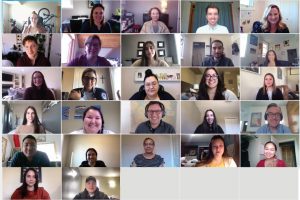By Bryce Lansdell
This summer I have been working remotely as an intern at the Indigenous Law Centre (ILC), based out of the University of Saskatchewan. My principal roles have been to work as a teaching assistant for the ILC’s summer program and to help with curriculum development for a certificate in Indigenous and Aboriginal law, the latter of which will be the subject of another blog post. The ILC summer program is offered to Indigenous law students who will be entering their first year of studies at a Canadian law school in September and allows these students to develop relationships with other future Indigenous legal professionals, gather valuable experience in developing the skills and habits necessary for law school, and lower the number of mandatory courses they will need to take in their first year. Students take two accredited courses: a class in Property law and a class called Kwayeskastasowin—a Cree phrase which roughly translates to “setting things right”—which serves as an introduction to Indigenous laws, worldviews, and how these laws are being revitalized in a colonial context.
Given that I have only completed one year of my law degree and that my studies have only been online, I was initially nervous that my lack of experience would make it difficult to work as a teaching assistant. Instead, I found that being able to clearly remember my first assignments, exams, and what it was like to develop studying techniques in law allowed me to give detailed feedback to students. I also found that having done my entire first year online, in which we learned to network and develop friendships exclusively virtually, gave me a helpful perspective in seeking to create contexts where students could connect both with the teaching assistants and with each other.
While I have enjoyed regularly meeting with students to help them prepare for assignments, midterms, and exams, one of the most meaningful experiences for me this summer started in the last week in May. I was in a morning call on Zoom with a student who was visibly distressed, and when I asked what was going on, she shared that many students in the program were upset about the “news in Kamloops.” This was the first I had heard about what turned into multiple findings of missing and unmarked graves across Canada this summer. I was uncertain of what to say to the student when presented with the news that 215 unmarked graves had been found at a residential school. Not being overly good at reacting well to the unexpected on the spot, I tried to express how horrible the situation was without much success before we continued our discussion of course material. However, I left the meeting with my heart feeling quite heavy. Although I was aware of the Truth and Reconciliation Commission’s Calls to Action regarding missing and unmarked graves at residential schools, hearing this news directly from an Indigenous student made the pain and suffering from residential schools feel far more real to me than it had been previously.[1]
In the coming week for both courses, we were sure to check in with how students were doing and made space for students to share with the class how they were processing the news. Though what was shared is confidential, I found it heartbreaking to hear about how personal and close to home the harm of residential schools is for so many of the students, their families, and their communities. Later, in a meeting with ILC Director Marilyn Poitras, Marilyn shared frustration and dismay that Indigenous people’s testimonies about residential schools were only being reckoned with now that bodies have been identified, despite there having long been various accounts of unmarked graves and higher than reported death rates at residential schools in Indigenous communities, despite the Truth and Reconciliation Commission’s 2015 report on Missing Children and Unmarked Burials,[2] and despite reports even in the early 20th Century by Dr. Peter Henderson Bryce about the appalling conditions and high death rate in residential schools which were ignored by the government.[3]
Although hearing of the grief and frustration of the students was heartbreaking, I also felt very honoured and privileged to be in the classroom with them. While I am only in the early stages of learning what role I can play in reconciliation, I believe one thing I can personally do is to spend more time listening to and learning from the stories and experiences of Indigenous people. In turn, I am very grateful for the opportunity that my internship with the ILC has afforded me to do so this summer.

[1] See Truth and Reconciliation Commission of Canada, Truth and Reconciliation Commission of Canada: Calls to Action (Winnipeg: TRC, 2015) at Calls to Action 71-76 <http://trc.ca/assets/pdf/Calls_to_Action_English2.pdf>.
[2] See Truth and Reconciliation Commission, Missing Children and Unmarked Burials in Canada’s Residential Schools: The Final report of the Truth and Reconciliation Commission of Canada, vol 4 (Montreal: McGill-Queen’s University Press, 2015) <http://www.trc.ca/assets/pdf/Volume_4_Missing_Children_English_Web.pdf>.
[3] See P.H. Bryce, The Story of a National Crime: An Appeal for Justice to the Indians of Canada (Ottawa: James Hope & Sons, 1922).
